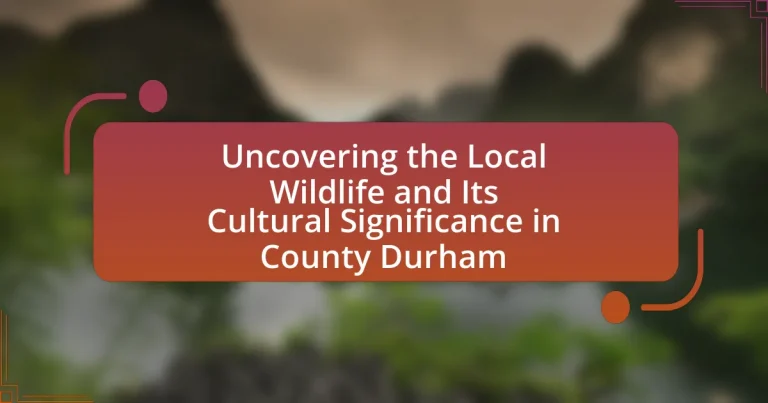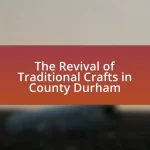The article focuses on the local wildlife and its cultural significance in County Durham, highlighting the region’s rich biodiversity, which includes species such as red squirrels, otters, curlews, and lapwings. It discusses the diverse habitats that support this wildlife, including woodlands, wetlands, and coastal areas, and emphasizes the ecological roles these species play in maintaining ecosystem health. Additionally, the article explores the cultural connections between wildlife and the community, detailing how local traditions, folklore, and events celebrate and promote awareness of the region’s natural heritage. It also outlines opportunities for residents and visitors to engage with and contribute to wildlife conservation efforts in County Durham.
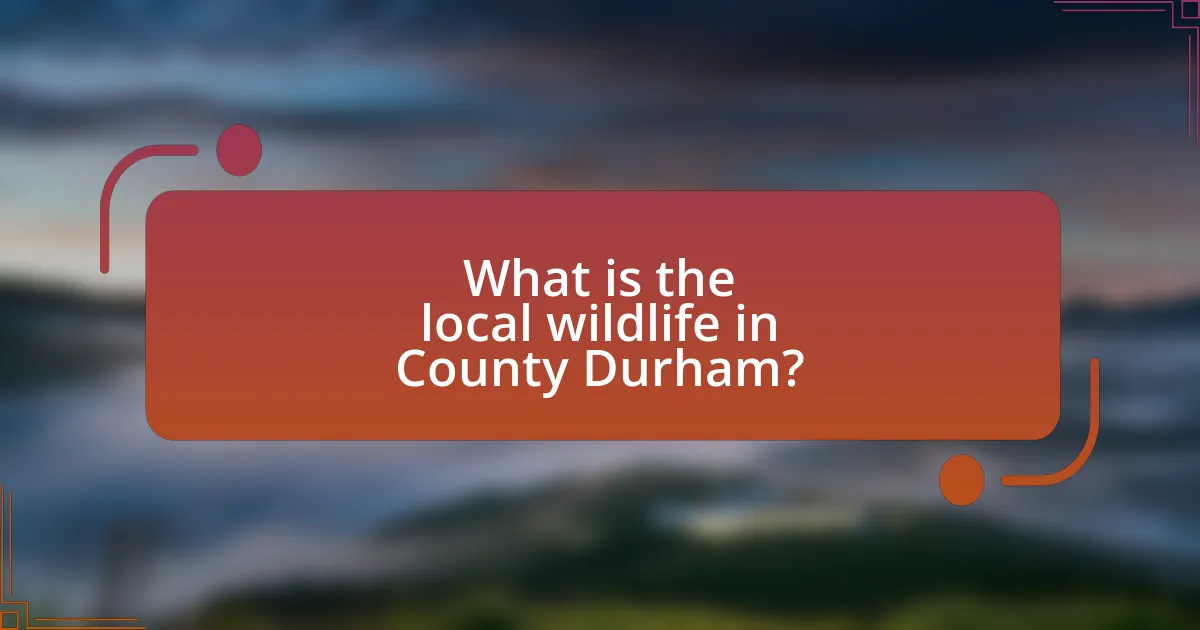
What is the local wildlife in County Durham?
County Durham is home to a diverse range of wildlife, including species such as red squirrels, otters, and various bird species like the curlew and lapwing. The region’s varied habitats, including woodlands, wetlands, and coastal areas, support this rich biodiversity. For instance, the North Pennines Area of Outstanding Natural Beauty is known for its unique flora and fauna, including rare species like the black grouse. Additionally, the Tees Estuary provides a vital habitat for migratory birds, highlighting the ecological importance of County Durham’s wildlife.
How diverse is the wildlife in County Durham?
The wildlife in County Durham is highly diverse, featuring a range of habitats that support various species. This region includes coastal areas, woodlands, moorlands, and rivers, which collectively host over 1,000 species of plants and numerous animal species, including birds, mammals, and insects. Notably, the North Pennines Area of Outstanding Natural Beauty within County Durham is home to rare species such as the black grouse and the red squirrel, highlighting the ecological richness of the area. Additionally, the presence of Sites of Special Scientific Interest (SSSIs) further underscores the importance of wildlife diversity in County Durham, as these sites are designated for their unique flora and fauna.
What are the key species found in County Durham’s ecosystems?
Key species found in County Durham’s ecosystems include the red squirrel, otter, and various species of birds such as the curlew and lapwing. The red squirrel is notable for its declining population in the UK, with County Durham being one of the remaining strongholds. Otters are indicators of healthy waterways, reflecting the quality of aquatic ecosystems. Additionally, the curlew and lapwing are significant for their cultural and ecological roles, as they are associated with traditional farmland and wetlands in the region. These species highlight the biodiversity and ecological importance of County Durham’s natural habitats.
How do seasonal changes affect wildlife in the region?
Seasonal changes significantly affect wildlife in County Durham by influencing breeding patterns, migration, and food availability. For instance, many bird species migrate to warmer climates during winter, while others, like the red squirrel, adapt their behavior and diet based on seasonal food sources such as nuts and seeds. Additionally, the timing of flowering plants in spring affects pollinators like bees, which rely on these plants for sustenance. Research indicates that shifts in temperature and precipitation patterns due to climate change are altering these seasonal cues, impacting wildlife populations and their habitats.
What habitats support wildlife in County Durham?
County Durham supports a variety of habitats that are crucial for wildlife, including woodlands, wetlands, grasslands, and coastal areas. These habitats provide essential resources such as food, shelter, and breeding grounds for numerous species. For instance, the North Pennines Area of Outstanding Natural Beauty features diverse upland habitats that are home to species like red grouse and various raptors. Additionally, the River Wear and its tributaries create wetland environments that support aquatic life and migratory birds. The coastal regions, particularly around Hartlepool, offer habitats for seabirds and marine life, contributing to the area’s biodiversity.
What role do woodlands play in local biodiversity?
Woodlands play a crucial role in local biodiversity by providing habitat for a diverse range of species, including plants, animals, and microorganisms. These ecosystems support complex food webs and contribute to genetic diversity, which is essential for resilience against environmental changes. For instance, studies have shown that woodlands can host over 1,000 species of vascular plants and numerous animal species, including birds, mammals, and insects, thereby enhancing the overall ecological health of the region. Additionally, woodlands contribute to ecosystem services such as carbon sequestration, soil stabilization, and water regulation, further supporting local biodiversity.
How do wetlands contribute to wildlife conservation?
Wetlands contribute to wildlife conservation by providing essential habitats for diverse species, including birds, amphibians, and aquatic life. These ecosystems support biodiversity by offering breeding grounds, food sources, and shelter, which are critical for the survival of many species. For instance, studies have shown that wetlands can support up to 40% of the world’s plant and animal species, despite covering only about 6% of the Earth’s surface. Additionally, wetlands play a vital role in maintaining ecological balance by filtering pollutants and regulating water cycles, which further enhances the health of surrounding wildlife populations.
Why is it important to study local wildlife?
Studying local wildlife is crucial for understanding ecosystem health and biodiversity. Local wildlife serves as indicators of environmental changes, helping to assess the impact of human activities and climate change on ecosystems. For instance, research has shown that monitoring species populations can reveal shifts in habitat quality and the effects of pollution. Additionally, local wildlife contributes to cultural identity and heritage, as seen in County Durham, where specific species are integral to community traditions and local lore. Understanding these connections fosters conservation efforts and promotes sustainable practices that benefit both wildlife and human communities.
What ecological roles do local species play?
Local species in County Durham play crucial ecological roles, including pollination, seed dispersal, and maintaining soil health. For instance, bees and butterflies are essential pollinators that facilitate the reproduction of flowering plants, which in turn supports local food webs. Additionally, birds and mammals contribute to seed dispersal, promoting plant diversity and ecosystem resilience. Soil organisms, such as earthworms, enhance soil structure and nutrient cycling, which are vital for plant growth. These interactions underscore the interconnectedness of species and their environments, highlighting the importance of biodiversity in sustaining healthy ecosystems.
How does wildlife contribute to the local economy?
Wildlife contributes to the local economy by attracting tourism, which generates revenue for businesses and creates jobs. In County Durham, the presence of diverse wildlife, including birds and mammals, draws visitors for activities such as birdwatching, hiking, and photography. According to a report by the UK Government, wildlife tourism contributes approximately £2 billion annually to the economy, supporting local accommodations, restaurants, and tour operators. This economic impact underscores the importance of wildlife conservation and management in sustaining local livelihoods.
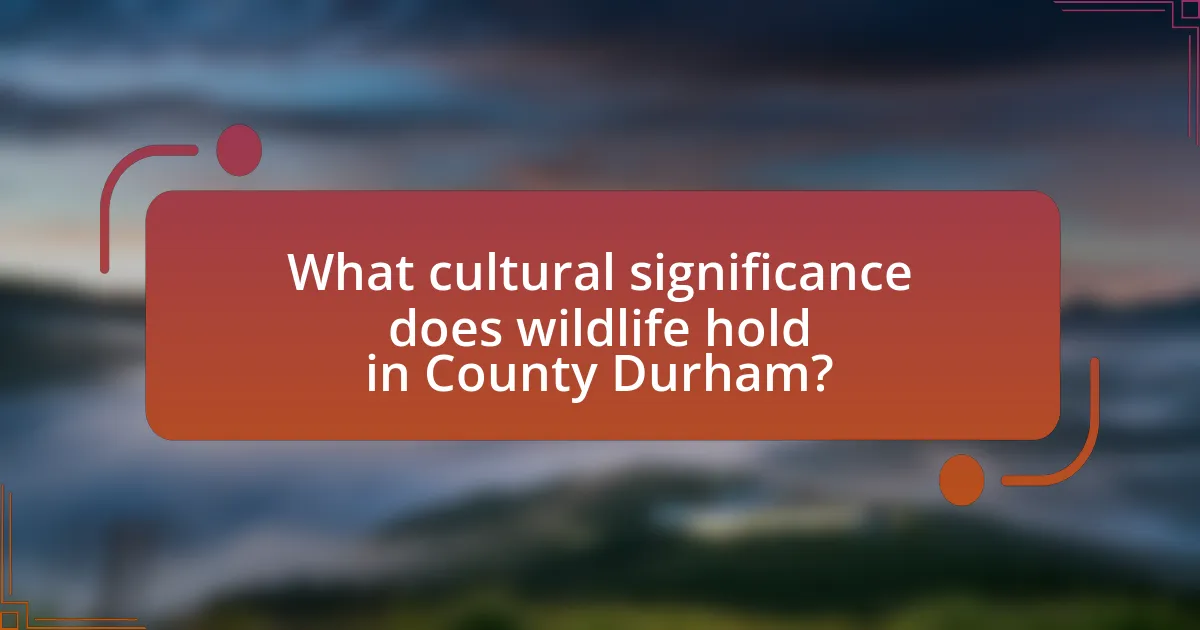
What cultural significance does wildlife hold in County Durham?
Wildlife in County Durham holds significant cultural importance as it is deeply intertwined with the region’s identity, heritage, and community activities. The presence of diverse species and natural habitats contributes to local traditions, folklore, and art, reflecting the historical relationship between the people and their environment. For instance, the annual events celebrating local wildlife, such as birdwatching festivals and conservation initiatives, foster community engagement and awareness of ecological preservation. Additionally, wildlife serves as a source of inspiration for local artists and writers, further embedding it into the cultural fabric of County Durham.
How has local wildlife influenced County Durham’s culture?
Local wildlife has significantly influenced County Durham’s culture by shaping local traditions, art, and community identity. The presence of diverse species, such as the red squirrel and various bird populations, has inspired local folklore and artistic expressions, evident in regional crafts and literature. For instance, the red squirrel is not only a symbol of conservation efforts but also features in local storytelling, reflecting the community’s connection to its natural environment. Additionally, wildlife-related events, such as birdwatching festivals, foster community engagement and promote environmental awareness, further embedding wildlife into the cultural fabric of County Durham.
What traditional practices are linked to local wildlife?
Traditional practices linked to local wildlife in County Durham include the use of specific hunting and fishing techniques, as well as seasonal festivals that celebrate local fauna. For instance, the practice of using traditional nets for fishing in the River Wear reflects a long-standing relationship between the community and its aquatic wildlife. Additionally, events like the annual “Durham Wildlife Festival” highlight the cultural significance of local species, promoting conservation and awareness. These practices are rooted in historical customs that emphasize sustainability and respect for the natural environment, showcasing the community’s deep connection to its wildlife.
How do local festivals celebrate wildlife and nature?
Local festivals celebrate wildlife and nature by organizing events that highlight local flora and fauna, promote conservation efforts, and engage the community in educational activities. For instance, festivals often feature guided nature walks, wildlife exhibits, and workshops that teach participants about the importance of biodiversity and habitat preservation. In County Durham, events like the Durham Wildlife Trust’s annual festival showcase local species and their habitats, fostering a deeper appreciation for the region’s natural heritage. These celebrations not only entertain but also raise awareness about environmental issues, encouraging sustainable practices among attendees.
What stories and folklore are associated with local wildlife?
Local wildlife in County Durham is associated with various stories and folklore, particularly those involving animals like the fox, owl, and hare. For instance, the fox is often depicted as a cunning trickster in local tales, symbolizing cleverness and adaptability. The owl, revered in many cultures, is frequently associated with wisdom and is featured in folklore as a guardian of the night. Additionally, the hare is linked to fertility and rebirth in local myths, often appearing in springtime stories that celebrate renewal. These narratives reflect the cultural significance of wildlife in shaping community identity and values in County Durham.
How do these narratives shape community identity?
Narratives about local wildlife significantly shape community identity by fostering a shared sense of belonging and cultural heritage among residents of County Durham. These stories often highlight the unique flora and fauna of the region, creating a collective memory that reinforces local pride and environmental stewardship. For instance, the celebration of specific species, such as the red squirrel, not only emphasizes the ecological importance of preserving local habitats but also connects community members through shared experiences and traditions related to wildlife observation and conservation efforts. This connection is evidenced by community events and educational programs that promote awareness of local biodiversity, thereby strengthening the community’s identity as stewards of their natural environment.
What role does wildlife play in local art and literature?
Wildlife significantly influences local art and literature by serving as a source of inspiration and cultural identity. In County Durham, artists and writers often depict native species and landscapes, reflecting the region’s biodiversity and natural beauty. For instance, the works of local poets frequently incorporate imagery of local fauna, which not only enhances the aesthetic quality of their poetry but also fosters a deeper connection to the environment. Additionally, visual artists create pieces that celebrate wildlife, contributing to community awareness and appreciation of ecological issues. This interplay between wildlife and creative expression underscores the importance of nature in shaping local narratives and cultural heritage.
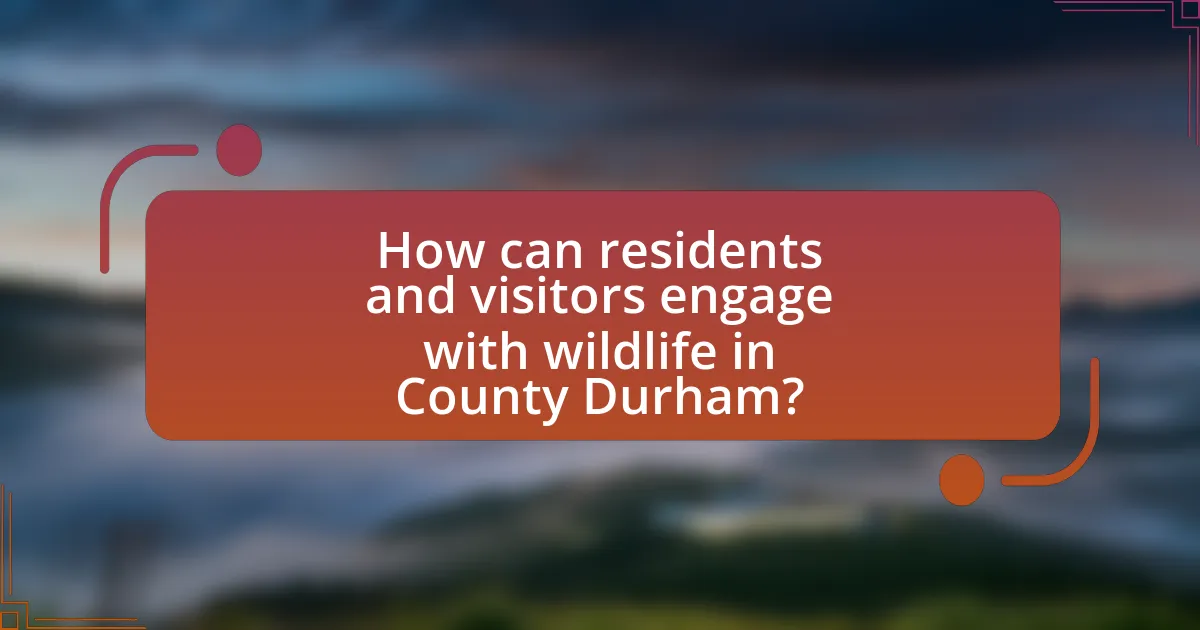
How can residents and visitors engage with wildlife in County Durham?
Residents and visitors can engage with wildlife in County Durham through various activities such as visiting nature reserves, participating in guided wildlife walks, and attending local wildlife events. Nature reserves like the Teesdale and Weardale areas provide habitats for diverse species, allowing individuals to observe wildlife in their natural settings. Guided walks, often led by local experts, offer educational insights into the region’s flora and fauna, enhancing the experience. Additionally, events organized by wildlife conservation groups, such as birdwatching days or wildlife photography workshops, foster community involvement and awareness of local biodiversity. These activities not only promote engagement but also contribute to the conservation efforts in the area.
What are the best practices for wildlife observation?
The best practices for wildlife observation include maintaining a respectful distance, using binoculars or cameras for a closer view, and minimizing noise to avoid disturbing animals. Observers should also research local wildlife habits and habitats to enhance their understanding and appreciation. For instance, studies show that approaching wildlife too closely can lead to stress and altered behaviors, which underscores the importance of keeping a safe distance. Additionally, observing during early morning or late afternoon increases the chances of sightings, as many species are more active during these times.
How can individuals contribute to wildlife conservation efforts?
Individuals can contribute to wildlife conservation efforts by participating in local conservation programs, volunteering for habitat restoration projects, and supporting wildlife protection initiatives. Engaging in these activities helps to preserve biodiversity and maintain ecosystems. For instance, in County Durham, local organizations often seek volunteers for tree planting and clean-up events, which directly benefit wildlife habitats. Additionally, individuals can advocate for wildlife-friendly policies and educate others about the importance of conservation, thereby fostering a community that values and protects local wildlife.
What resources are available for learning about local wildlife?
Resources for learning about local wildlife include field guides, online databases, local wildlife organizations, and educational programs. Field guides provide detailed information on species found in specific regions, while online databases like the National Biodiversity Network offer access to species distribution data. Local wildlife organizations, such as the Durham Wildlife Trust, often conduct workshops and guided walks to educate the public about local ecosystems. Educational programs in schools and community centers also focus on wildlife conservation and biodiversity, enhancing awareness and understanding of local species and their habitats.
What activities promote awareness of wildlife in County Durham?
Activities that promote awareness of wildlife in County Durham include guided nature walks, wildlife photography workshops, and educational programs at local nature reserves. Guided nature walks, often led by experts, provide participants with insights into local flora and fauna, enhancing their understanding of biodiversity. Wildlife photography workshops encourage individuals to capture images of native species, fostering a deeper appreciation for wildlife. Educational programs at nature reserves, such as the RSPB Saltholme, offer hands-on experiences and information about conservation efforts, further raising awareness about the importance of protecting local ecosystems. These activities collectively contribute to a greater public understanding of wildlife and its significance in County Durham.
How can guided tours enhance the understanding of local ecosystems?
Guided tours enhance the understanding of local ecosystems by providing expert insights and contextual information about the flora and fauna present in the area. These tours often include knowledgeable guides who can explain complex ecological relationships, such as predator-prey dynamics and the impact of human activity on habitats. For instance, a study by the University of California found that guided nature walks significantly improved participants’ knowledge of local biodiversity, with a 40% increase in species identification skills post-tour. This structured learning experience fosters a deeper appreciation for the interconnectedness of species and their environments, ultimately promoting conservation awareness and responsible stewardship of local ecosystems.
What volunteer opportunities exist for wildlife enthusiasts?
Wildlife enthusiasts can engage in various volunteer opportunities such as habitat restoration, wildlife monitoring, and educational outreach programs. Organizations like the Durham Wildlife Trust offer structured volunteer programs where individuals can participate in activities like planting native species, conducting bird surveys, and leading community workshops on local wildlife. These initiatives not only support conservation efforts but also enhance public awareness of the ecological significance of local wildlife in County Durham.
What tips can help foster a deeper appreciation for local wildlife?
To foster a deeper appreciation for local wildlife, individuals can engage in regular nature walks to observe and learn about native species in their habitats. This practice not only enhances awareness of biodiversity but also encourages a personal connection to the environment. Research indicates that spending time in nature can improve mental well-being and increase environmental stewardship, as highlighted in a study by the University of Exeter, which found that people who engage with nature are more likely to support conservation efforts. Additionally, participating in local wildlife conservation programs or citizen science projects can provide hands-on experience and knowledge about local ecosystems, further deepening appreciation for wildlife.
